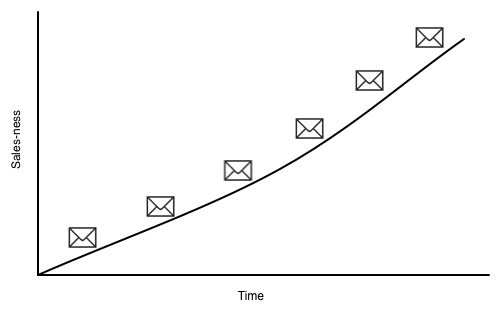
You’ve worked so hard.
You’ve written an incredible post.
You know your audience will be delighted, as your post has heaps of actionable ideas on how they can make their lives better. You’ve even tweaked the headline to perfection. It grabs attention. It arouses curiosity. It’s got it all.
You publish the post and get some good sharing activity and attention, but then you noticed in your analytics tool that nothing good actually happened.
You got all this traffic to the post but then everyone just left. Nobody signed up for your product or requested a demo.
It’s a feeling that is all too familiar for content marketers out there. You can get some great traffic, but it doesn’t convert into paying customers and leaves you feeling like you should just throw in the towel and go back to Google Adwords.
Enter the Hail Mary offer.
What is a Hail Mary Offer?
The Hail Mary Offer is the offer you make when everything else you’ve tried to do has failed to convert the user, either directly into a customer or even into a lead or subscriber.
More technically speaking, the Hail Mary Offer is a broad-appealing offer you make in an exit intent popup to ‘New Visitors’ who are exiting after one page (i.e. are about to bounce). It’s great for high-bounce rate sections of websites like blogs, where majority of people generally come in from search engines and social networks like Twitter, consume the piece of content they were looking for and then leave.
I’ve seen plenty of different offers used before, from T-shirts and different swag items to educational courses and eBooks. The offer you make largely depends on your target market, but in order to be effective it needs to have the following characteristics:
- Be so top of funnel it’s almost out of the funnel – Don’t forget these people were about to leave, so they’re not likely to be very far down the buying cycle. The offer you make can’t be a buyers guide to your software, it needs to be something that is going to appeal to them even if they aren’t really interested in buying your product at that point in time (which doesn’t mean they won’t be in the future by the way).
- Be widely appealing – Given that these people are ‘browsers’ and have come to your site for a wide variety of reasons (usually just to consume a single piece of content that either caught their interest on a social feed or met an information need they had at that moment), your offer needs to have broad appeal. This is why I think things like T-shirts or swag work really well here as everybody loves some free swag, particularly if it’s unbranded (more on that later).
How do I implement a Hail Mary Offer?
The best part about the Hail Mary Offer is that it’s super simple to implement. Here’s a simple walk-through in 3 easy steps:
Step 1: Think of a broadly appealing offer
To start off with, you need to come up with a broadly appealing offer. One that still narrow enough that it will appeal to your target market and not just everybody, but still broad enough that it will appeal to people regardless of how or why they ended up on your site.
The best offer I have seen is by the folks over at InVision. For their Hail Mary Offer, they got Kyle Steed (a well known and respected designer) to design a T-shirt that says “Design makes everything possible’.

Not sure why that’s so great? Here’s why:
- It’s unbranded – Somebody who has just landed on your website and is about to bounce doesn’t want to start wearing your company name around on their shirt in front of their friends, so by choosing to make it unbranded they broadened the appeal of the offer significantly.
- It aligns with their target market – Their target market is designers, and I can tell you from experience these people think design does makle everything possible (and I tend to agree with them actually). By removing their branding but also going with a statement their target audience believes in, they make the offer really appealing to the kind of people they want to enter their email address, their potential customers.
- It positions their brand amazingly – By going for such a statement on the tshirt, they instantly align their brand values with the values of their users. According to a HBR study, shared values is the number one cause of brand loyalty, and this offer is creating brand loyalty for InVision in spades.
In the situation where the offer isn’t easily or cheaply given away to every person (I.e. a Isn’t a digital product), you could consider doing a competiton where you give away one of the offer every week to people who enter their email address that week. That way, you don’t giving away thousands of tshirts every month at a seriously negative ROI.
Step 2: Design the offer and add it to an exit-intent popup
Nest step is to design the offer and put it into an exit-intent popup on your site.
I won’t go into detail about this as you can choose whatever design you like and whatever popup tool works best for your CMS and unique technical attributes.
I will however recommend a tool you may want to check out. I use Pippity on this blog (a free WordPress plugin) and that has all the functionality you’d need to make this work, including the targeting abilities to only show on when a new user is bouncing from a specific content section on your site.
Step 3: Target it at new users who are exiting after just one page, and only on high bounce rate areas of your site.
This one is a bit more optional, but I personally believe popups tend to ruin the user experience of a website.
I would therefore only show it to New Visitors who are exiting after just one page, and I would also only show it on high-bounce, free content areas like a blog.
That way, considering it’s an exit popup your not really affecting the experience a user has while they are on your site, and even if someone does take a disliking to being shown a popup on exit they are the kind of people who would be leaving and likely not returning anyway.
I personally would never implement a tactic like this on a page of the marketing site or anywhere you could reasonably think the visitors is further down the buying funnel and therefore of higher value.
What do I do with all the email addresses I collect?
The key to generating a positive ROI is making sure you do something with the email addresses that come in that leads to sales.
I’d recommend setting up an auto-responder series using an email marketing tool like Campaign Monitor (disclaimer: I work for them). Conveniently enough, Campaign Monitor integrates directly with Pippity to automatically send people’s email addresses to a designated list and then start sending them the auto-responder series.
In terms of what to content to put in your auto-responder series, I’d recommend following a similar plan to what I outlined in my post Creating a Growth Engine for your SaaS product (which to be fair, was based on Patrick McKenzie’s writings on the subject).
Essentially, he recommends a series of 8 emails over 30 days that increase in ‘Salesness’ as time goes on:

A simple email lead nurturing campaign could be as follows:
- The problem email – Designed to break the status quo (remember; everybody is using something else to achieve what your product does, whether it be pen & paper, excel, email, whatever) and open the reader to the possibilities of replacing their existing process with software. This email should focus on educating readers on the problems associated with their current method and should barely mention your product.
- The benefit email– A look at the benefits of using software like yours to achieve whatever it is your product achieves. This email should focus on the benefits of using your category of product (I.e. person-based analytics tools as opposed to KISSmetrics directly) and how it can help improve their lives.
- The transition email – As mentioned before, everybody is switching from something and the switching process itself is a barrier you need to overcome. This email should focus on outlining a simple and easy process for making the switch to using software to achieve the problem.
- The tools email – An overview of the tools available to achieve what your product achieves, almost a quick buyers guide. This is the first time you introduce your product and outline why it’s superior to your competition. Include a CTA to signup for your free trial/free plan in this email.
- The case study email – A case study on how one of your customers uses your product, what problems it solves for them (tied to the problems outlined in the first email and what benefits it bring them (tied to the benefits outlined in the second email). Include a testimonial from you customer and a CTA to signup for your free trial/free plan in this email.
- The resources email – The final email. Suggest some other eBooks, blogs, templates, kits, etc for learning more about whatever it is your product does. Include a CTA to signup for your prdocut with a discount code or special offer as if you havent converted from the previous emails, a special offer can help tip them over the edge.
Whilst this is just an example campaign, you can see that the focus is on educating prospects rather than making the hard sale. Only once they have been sufficiently educated on the problems of their existing approach and the benefits of replacing it with software do you introduce your product and make an offer, at which point they are much more likely to signup for your free trial/free plan.
This sounds like a cool idea, but does it really get results?
To be honest, it doesn’t matter. All I could tell you here is whether or not it has worked for other companies (which it has), but they’re not you.
They have different target markets, different products, different sales cycles, different brands. The only way to know whether this will work is to test it yourself.
If you’re really hesitant to do that, you could run a ‘lean’ test on this by simply implementing the popup, connecting it to an email marketing tool and then sending an email to whoever enters their email address saying you’ll send through the offer in a few days. It’s not ideal, but at least that way you can test whether the idea will work for your business without designing and printing 1000 t-shirts.


The “Hail Mary Offer” Trick #55 |
10.01.2016 at 02:09[…] Source of inspiration: https://aaronbeashel.com/the-hail-mary-offer/ […]